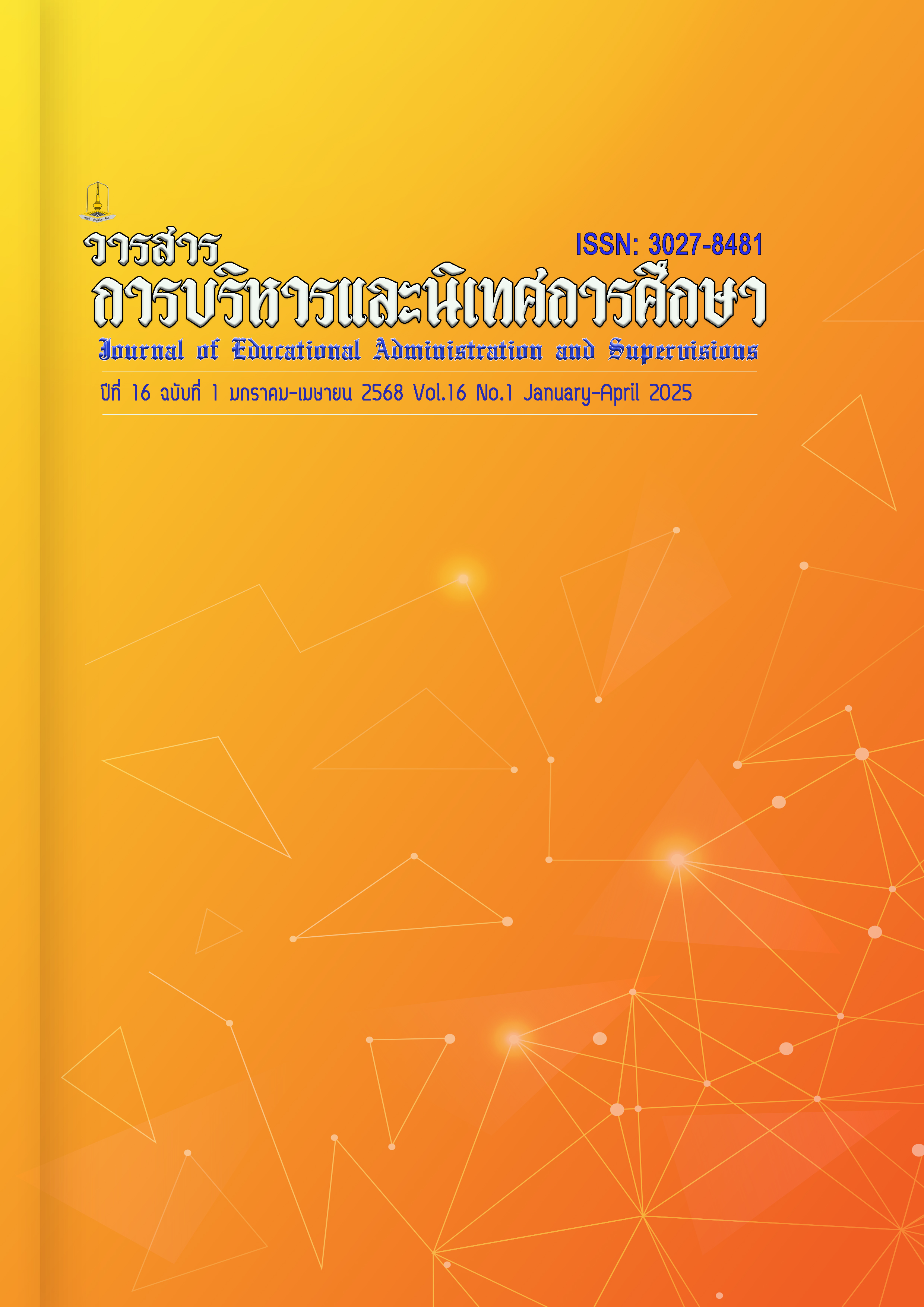Prevention and Solution Guidelines of Bullying Behaviors Among Sports Program Students of Upper Secondary Education Level in Extra-large Schools
Main Article Content
Abstract
The objectives of this research were 1) to study the characteristics and severity of bullying behaviors among students, 2) to examine the level of perception when bullying behaviors occur among students, and 3) to identify guidelines for preventing and addressing bullying behaviors among students. This research employed a quantitative approach. The population consisted of 102 high school students in the sports education program at an extra-large secondary school in the 2024 academic year. The research instrument was a 34-item questionnaire on student bullying behaviors. Data analysis was conducted using statistics including frequency distribution, mean, percentage, and standard deviation.
The research findings revealed that 1) The characteristics and severity of bullying behaviors were found to be at a low level overall. When examining individual aspects, the most commonly experienced form of victimization was being subjected to violence during sports play or practice, with the severity of bullying behavior at a low level (μ= 2.41). The most common form of perpetrating bullying was punching, kicking, pushing, or hitting others' bodies, with the severity of bullying behavior at a low level (μ= 2.57). 2) The overall perception of bullying behaviors was at a relatively low level. 3) Guidelines for preventing and addressing bullying behaviors among students in the sports education program identified six categories: developing students' social and emotional skills, creating a safe and equitable environment, establishing and enforcing school regulations, defining teachers' roles and vigilance, building collaborative networks with parents, coaches, and relevant stakeholders, and implementing case-by-case management.
Downloads
Article Details

This work is licensed under a Creative Commons Attribution-NonCommercial-NoDerivatives 4.0 International License.
References
กระทรวงศึกษาธิการ. (2565). ประกาศกระทรวงศึกษาธิการ เรื่อง นโยบายและจุดเน้นของกระทรวงศึกษาธิการ ประจำปีงบประมาณ พ.ศ. 2567. https://www.moe.go.th/360policy-and-focus-moe-fiscal-year-2024/
กองทุนเพื่อความเสมอภาคทางการศึกษา. (2567). 7 สาเหตุที่ทำให้เด็กออกนอกระบบการศึกษา. https://www.eef.or.th/infographic-7-reasons/
เชาวรัตน์ เขมรัตน์ ,สุพัชริน เขมรัตน์ และ อภิลักษณ์ เทียนทอง. (2565). อิทธิพลของความเชื่อมั่นทางกีฬาที่ส่งผลต่อความสำเร็จในการแข่งขันกีฬา. วารสารวิทยาศาสตร์และเทคโนโลยี มหาวิทยาลัยเกษตรศาสตร์, 11(3), 24-32. https://kuojs.lib.ku.ac.th/index.php/jstku/article/view/5134
ณัฎฐาภรณ์ โสกัณฑัต. (2566). พฤติกรรมการรังแกกันของนักเรียนในประเทศไทยผ่านมุมมองอาชญาวิทยา. วารสารกระบวนการยุติธรรม, 16(3), 35-49. https://so04.tci-thaijo.org/index.php/JTJS/article/view/260830
ทวีศักดิ์ สิริรัตน์เรขา. (2565). การบูลลี่. ศูนย์วิชาการแฮปปี้โฮม. https://www.happyhomeclinic.com/mh11-bullying.html
ธณัศมนต์ จั้นอรัญ, สุณีย์ กัลป์ยะจิตร, พงษ์ธร ธัญญสิริ และ ศุภกร ปุญญฤทธิ์. (2560). การรับรองและคุ้มครองสิทธิในความเป็นอยู่ส่วนตัวของผู้ถูกข่มเหงรังแกบนไซเบอร์ [วิทยานิพนธ์ปริญญามหาบัณฑิต,จุฬาลงกรณ์มหาวิทยาลัย]. https://cuir.car.chula.ac.th/bitstream/123456789/59714/1/5885981834.pdf
บงกช จันทร์สุขวงค์. (2562). รูปแบบการจัดการกีฬาเพื่อความเป็นเลิศในโรงเรียนกีฬาสังกัดมหาวิทยาลัยการกีฬาแห่งชาติ กระทรวงการท่องเที่ยวและกีฬา [วิทยานิพนธ์ปริญญาดุษฎีบัณฑิต, มหาวิทยาลัยนเรศวร]. https://nuir.lib.nu.ac.th/dspace/bitstream/123456789/1548/3/59032415.pdf
รังสรรค์ โฉมยา. (ม.ป.ป.) สเกลคู่ มิติใหม่การใช้แบบวัดมาตราส่วนประมาณค่าลิเคิร์ท. ภาควิชาจิตวิทยาการศึกษาและการแนะแนว คณะศึกษาศาสตร์ มหาวิทยาลัยมหาสารคาม. http://thesis.swu.ac.th/swuarticle/Ed_Tech/Ed_Techv13n1p145.pdf
วิมลวรรณ ปัญญาว่อง. (2562). การป้องกันและการจัดการรังแกกันในโรงเรียน. วารสารสุขภาพจิตแห่งประเทศไทย, 27(2), 133-144. https://he01.tci-thaijo.org/index.php/jmht/article/view/204156
ศุภรดา ชุมพาลี และ ทัศนา ทวีคูณ. (2562). พฤติกรรมรังแกกันของนักเรียนชั้นมัธยมศึกษาตอนต้นของจังหวัดหนึ่งในภาคกลาง ประเทศไทย. วารสารการพยาบาลจิตเวชและสุขภาพจิต, 33(3), 128-148 https://he02.tci-thaijo.org/index.php/JPNMH/article/view/232462
สุริยา ฆ้องเสนาะ. (2561). ปัญหาการรังแกกัน (Bullying) ในสถานศึกษา. สำนักวิชาการ สำนักงานเลขาธิการสภาผู้แทนราษฎร. https://dl.parliament.go.th/handle/20.500.13072/536994
สมบัติ ตาปัญญา. (2549). รายงานการสำรวจปัญหาการรังแกกันของนักเรียน. ภาควิชาจิตเวชศาสตร์ คณะแพทยศาสตร์ มหาวิทยาลัยเชียงใหม่. https://dol.thaihealth.or.th/resourcecenter/sites/default/files/documents/_kaarsueksaaephuuephathnaaruupaebbaenwthaangka.pdf
สำนักงานเลขาธิการสภาการศึกษา. (2560). แผนการศึกษาแห่งชาติ พ.ศ.2560-2579. สำนักงานเลขาธิการสภาการศึกษา.
อนุรักษ์ จันทร์รอด. (2565). การศึกษาความรุนแรงของพฤติกรรมการกลั่นแกล้งกันของนักเรียนในโรงเรียนอำเภอเมือง จังหวัดพิษณุโลก. วารสารการจัดการและพัฒนาท้องถิ่น มหาวิทยาลัยราชภัฏพิบูลสงคราม, 2(1), 49-59. https://so06.tci-thaijo.org/index.php/jclmd_psru/article/view/257008
Freud, S. (1962). Further remarks on the neuro-psychoses of defence. https://www.lacanonline.com/2010/05/reading-further-remarks-on-the-neuro-psychoses-of-defence/
Olweus, D. (1996). The revised olweus bully/victim questionnaire. Research Center for Health Promotion (HEMIL Center), Bergen, University of Bergen. https://www.scirp.org/reference/referencespapers?referenceid=1795954
Laura Wood, Jennifer Smith, Kris Varjas, and Joel Meyers. (2017). School personnel social support and nonsupport for bystanders of bullying: Exploring student perspectives. Journal of School Psychology, 61, 1-17. https://www.sciencedirect.com/science/article/abs/pii/S0022440516300735


